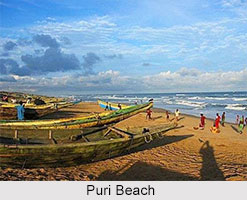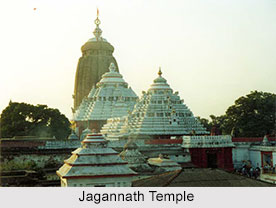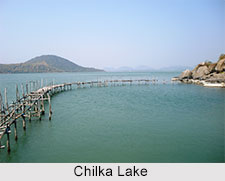 Puri District is the coastal district of Odisha and it is known for the famous temple called Jagannatha Temple. The district of Puri holds wealth of attraction for the visitors and at the same time boasts of a continuous history from the 3rd Century BC and its unique monuments like those of Lord Jagannath at Puri, the Sun God at Konark, which attained prominence and reputation not only in India but throughout the world. However, Puri District is known as the holy as the holy seat of the celebrated Lord Jagannath.
Puri District is the coastal district of Odisha and it is known for the famous temple called Jagannatha Temple. The district of Puri holds wealth of attraction for the visitors and at the same time boasts of a continuous history from the 3rd Century BC and its unique monuments like those of Lord Jagannath at Puri, the Sun God at Konark, which attained prominence and reputation not only in India but throughout the world. However, Puri District is known as the holy as the holy seat of the celebrated Lord Jagannath.
History of Puri District
Puri District has its origin from the early history of India. It became popular during the reign of Ashoka and later in the medieval era, when Eastern Ganga Dynasty ruled this place. Little information regarding the pre-historic cultures of this district is mainly derived from different types of stone tools collected from the surface. Under the rule of Mughal Dynasty (1592-1751), Odisha for the purpose of revenue administration was divided into three divisions. After their occupation of Odisha in 1751, the Marathas brought about some changes in the revenue divisions of the province. In June 1804, the province was divided into two divisions, namely the Northern and Southern Divisions, Mahanadi River forming the boundary. Finally on 23rd October 1828, the province was divided into three districts, namely Balasore, Cuttack and Jagannath, later known as Puri. In 1912 the new province of Bihar and Odisha was formed and subsequently Odisha became a separate province in 1936. After integration with Odisha an 1st January 1948 of the feudatory states of Nayagarh, Daspalla, Khandapara and Ranapur with a total area of 3941 sq kms a separate Sub-Division comprising these ex-states was added to Puri District with headquarters at Nayagarh. The old Puri District consisted of four sub-divisions namely Puri Sadar, Khurdha District, Bhubaneswar and Nayagarh District, Puri Sadar Sub-Division consists of four Tehsils - Krushna Prasad, Sadar, Pipili and Nimapara.
Geography of Puri District
Geography of Puri District may be divided into two dissimilar natural divisions - littoral tract and level alluvial tract. The littoral tract lies between the alluvial tract and the Bay of Bengal. The level alluvial tract is full of villages and rice fields. There is no hill in Puri District except a small cultivate land are under plough. The length of the sea-coast of the district is nearly 150.4 km. All the rivers of Puri District have a common characteristic. In the hot weather they are beds of sand with tiny streams or none at all, while in the rains they receive more water than they can carry. Generally all rivers are distributaries of Mahanadi River. By virtue of its geographical location, the climate of Puri District is equable through out the year.
Demography of Puri District
Puri district has a population of 1,697,983. This gives it a ranking of 291st in India out of a total of 640. The district has a population density of 488 inhabitants per square kilometre (1,260/sq mi). Its population growth rate over the decade 2001-2011 was 13%. Puri has a sex ratio of 963 females for every 1000 males, and a literacy rate of 85.37%.
Culture of Puri District
 Puri District is one of the fascinating littoral districts of Odisha .The cultural heritage of Puri with its long recorded history beginning from third century BC till present day, the monuments and religious sanctity, lifestyle of the people with their rich tradition posses emphatically to be the cultural heart of Odisha. Puri is considered as the cultural capital of Odisha. The culture here is flourished with its manifold activities. Puri District has the happy conglomerate of different religions, sects and faith in course of history. A number of fairs and festivals are organized in the district. Puri District is popular for its stone sculpture, Palm Leaf Painting, Tassar paintings, Pottery toys, sand art and applique work.
Puri District is one of the fascinating littoral districts of Odisha .The cultural heritage of Puri with its long recorded history beginning from third century BC till present day, the monuments and religious sanctity, lifestyle of the people with their rich tradition posses emphatically to be the cultural heart of Odisha. Puri is considered as the cultural capital of Odisha. The culture here is flourished with its manifold activities. Puri District has the happy conglomerate of different religions, sects and faith in course of history. A number of fairs and festivals are organized in the district. Puri District is popular for its stone sculpture, Palm Leaf Painting, Tassar paintings, Pottery toys, sand art and applique work.
Tourism in Puri District
Puri District and the nearby city, Bhubaneshwar is regarded as the land of temples. Exquisite temples, superb monuments, inviting beaches and natural landscape are some of the major attractions for the tourists. Tourism of Puri offers the rare opportunity of witnessing the sunrise and sunset on the same beach on its golden sands. Puri Beach attracts thousands of the tourists throughout the year. The Hindu temples and sanctuaries, Khandagiri and Udaigiri Caves, golden beaches and glorious lakes, crafts and the numerous festivals are added attractions for the visitors. Jagannath Temple, Konark Sun Temple, Chilka Lake are some of the main tourist attractions offered by Puri District.
Related Articles
Odisha, Indian state
Nature Tourism in Odisha
Districts of Odisha
Konark Temple, Odisha
Tourism of Puri
Art and Culture of Puri District
Culture of Puri
History of Puri District
History of Puri



















